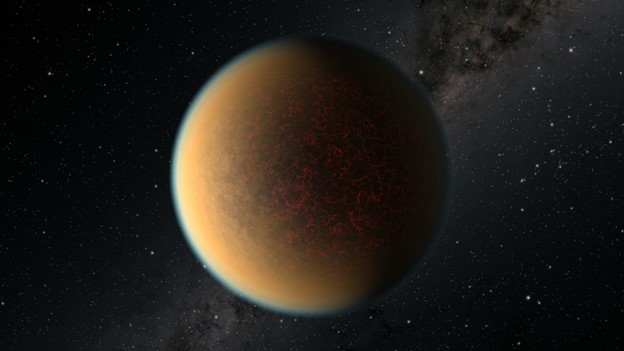
The planet GJ 1132 b was born a gaseous world with a thick blanket of atmosphere and several times the radius of Earth. The “sub-Neptune” lost its primordial hydrogen and helium atmosphere because of intense radiation from its hot, young star. Soon, it was reduced to a bare Earth-sized core.
Hubble recently uncovered a secondary atmosphere that replaced the planet’s first one. Rich in hydrogen, hydrogen cyanide, methane, and ammonia, it also has a hydrocarbon haze. Astronomers believe hydrogen from the original atmosphere was absorbed into the planet’s molten magma mantle and is now being released by volcanism forming a new atmosphere. This atmosphere continues to leak into space but is continually being replenished from the reservoir of hydrogen in the mantle’s magma.
GJ 1132 b has various parallels to Earth but is also very different. They have similar densities, similar sizes, and similar ages–4.5 billion years old. Both began with a hydrogen-dominated atmosphere, and both were hot before they cooled down. GJ 1132 b and Earth have similar atmospheric pressure at the surface.
There are several differences. Earth is not believed to be the surviving core of a sub-Neptune. And Earth orbits at a comfortable distance from its dwarf Sun. GJ 1132 b is so close to its host red dwarf star that it completes an orbit of the star once every day and a half. This keeps GJ 1132 b tidally locked, showing the same face to its star at all times — just as our moon keeps one hemisphere permanently facing Earth.
GJ 1132 b is in an elliptical orbit, and the tidal forces acting on it are strongest when it is closest to or farthest from its host star. At least one other planet in the host star’s system also exerts a gravitational pull on the planet. The consequences are that the planet is squeezed or stretched by this gravitational “pumping.” That tidal heating keeps the mantle liquid for a long time.
GJ 1132 b’s crust is extremely thin, perhaps only hundreds of feet thick. That’s much too feeble to support volcanic mountains. Its flat terrain may also be cracked like an eggshell by tidal flexing, allowing hydrogen and other gases to be released.
If astronomers use the James Webb Space Telescope to observe the planet, there’s a possibility that they will see not the spectrum of the atmosphere, but the spectrum of the surface. If there are magma pools or volcanism going on, those areas will be hotter. That will generate more emissions, they’ll be looking at the actual geological activity. This allows exoplanet scientists a way to figure out part of a planet’s geology from its atmosphere.
